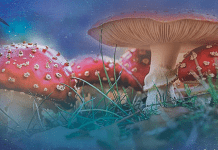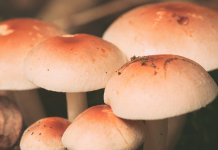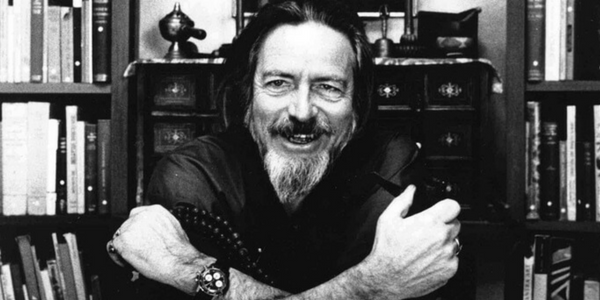
The New Psychedelic Revolution: The Genesis of the Visionary Ages, by James Oroc
Park Street Press, 9781620556627, 480 pp., 2018
James Oroc’s The New Psychedelic Revolution: The Genesis of the Visionary Age is absolutely sensational. It encompasses information on a broad spectrum of topics related to the use of entheogens, which are here defined as “psychedelic plant[s] or compound[s] capable of inducing the classical mystical experience.”1 Oroc answers the question, What potential do entheogens hold in shaping the future of consciousness in the 21st century?
At the outset, it seems as though the book will focus on visionary art. Yet, it delves into subjects such as the legality of psychedelic use, the place psychedelics occupy in modern culture, and the artistic inspiration of psychedelic use that is at the core of visionary art. Through the nearly 500-page book, Oroc guides the reader through a journey into the underground world of psychedelics that allows for a holistic representation of the interrelationships between art, culture, and entheogens to emerge.
As the book begins, Oroc focuses on a rare entheogen, 5-methoxy-DMT (5-MeO-DMT). He wrote extensively about his experience with this entheogen in his book Tryptamine Palaces, which put him on the map as an influencer in the psychedelic community. He offers a personal lens into his background that has shaped his writing, acknowledging the subjectivity of his own experience. While it is evident that Oroc has remained active in upholding and shaping the future of psychedelic culture through his speaking engagements, writing, and participation in festivals such as Burning Man, by no means does he claim this book to be an authority on the subject matter. I appreciate his humble approach.
The New Psychedelic Revolution is divided into four parts. The first part is a history of what Oroc calls the “Second Psychedelic Revolution,” the psychedelic re-emergence currently happening post the 1960s.2 An LSD drought hit the United States when the substance was made illegal in 1968. He notes this could have been the end of acid, but what happened instead was new entheogenic compounds emerged to fill its place, offering a widening of the on-going psychedelic revolution.
Oroc proceeds to cover the work of the heavy hitters in the psychedelic community: Alexander Shulgin, Terence McKenna, and Alex Grey. In their own way, each of these men has impacted the psychedelic culture at large through their dedicated research and work. I personally am tired of only hearing about these three men, and look forward to the psychedelic history being written to be more inclusive of a diversity of voices, including women and indigenous peoples. However, Oroc does offer a psychedelic history of the world to demonstrate the use of the entheogens through time, ranging from Meso-American cultures 5,700 years ago to the use of mescaline in the CIA’s MKUltra program.
The section concludes with a call that psychedelics may be the saviour to the ego-driven destruction happening globally at this time, including destruction of natural resources and climate change. He notes the connection between the use of LSD and the start of the environmental movement, which I found interesting to note and something I had not realized before.
Through his discussion with many activist-artists, Oroc has come to view the movement of visionary art as a re-emergence of the transpersonal reality, one often found in mythology, that has long been lost in the Western psyche. This is emerging through the rise in global festivals, such as BOOM! in Europe and Burning Man in the United States.
A mystical realization of God, based on scientific understanding of how this might be possible, would radically transform our own understanding, and could produce enough effective contemplative activists to bring about the massive shift in awareness that our society will need to survive the twenty-first century.3
I couldn’t agree more with this statement, and I am happy to see Oroc standing at the front lines of the need to merge the mystical and scientific through the use of entheogens.
Drawing on his own reflections and modern physicists, Oroc explains the concept of light and consciousness in a truly profound way. He offers the work of many physicists, such as David Bohm, Peter Russell, and Bernard Haisch as a basis for the conclusions he has reached; I eagerly look forward to exploring these findings as well.
This section also includes a fascinating chapter on microdosing LSD in the extreme sports community — again, something I was unaware of until reading about it this book. To conclude the section, Oroc presents possible futures for the use of psychedelics, while attempting to reconcile the gap created by harsh drug penalties, by showing psychedelics are hardly the most dangerous drugs of our time.
Part three, at long last, delves into the topic of visionary art. Though Oroc provides a history spanning back to prehistoric times of visionary art, the genre is newly formed, emerging through the psychedelic culture of the modern era. He notes the term psychedelic art and visionary art have become almost interchangeable. For each time frame, he focuses on a few key artists. I would have enjoyed a more elaborate explanation of each artist’s impact to their culture at the time and how it has helped to shape the modern visionary art; the descriptions were brief and hardly included anyone who was not a white, male artist.
The last few chapters are particularly interesting, because it is the most up to date synopsis. Oroc describes the culture of BOOM! and Burning Man, two well-known festivals that have become home bases for the visionary art movement’s growth and evolution. The relevance of this book, in addition to the style of writing, reminds me of Daniel Pinchbeck’s publication of 2012: The Return of Quetzalcoatl. It is similar to Pinchbeck’s novel because The New Psychedelic Revolution is also documenting the zeitgeist. To me, this book is effective in catching everyone up to speed on psychedelic culture. From this view, the reader is then able to think about what the future we work towards should be based on understanding where the culture stands.
The final section describes Oroc’s own personal experiences with entheogens, featuring only his legal and accidental stories. I enjoyed this section very much, because it adds a whole new layer. Due to the illegal status of most of the chemicals discussed, writers are often limited in the discussion of the personal experiences on these substances. It is ok to discuss them scientifically, such as Multidisciplinary Association for Psychedelic Studies (MAPS) is currently doing, or philosophically in regard to the hypothetical mystical experiences invoked, yet the personal is taboo. Oroc’s tales, quite varied and hilarious, add the absurd aspect of the beautifully volatile, yet inherently insightful nature of entheogens to the book.
I have to admit I get frustrated with the domination of the psychedelic movement told through the perspective of white cismen. I have devoured everything by Terence McKenna and absorbed Aldous Huxley, Timothy Leary, Shulgin, and Pinchbeck. Yet, I constantly wonder where women’s voices are within the movement. Oroc only focuses on a few women artists in his discussion of visionary art. I feel one of the greatest shifts in psychedelic culture will be to include the voice and leadership of women who tell the tale of their entheogenic experiences as well. This sentiment extends towards people of colour and indigenous people too. The true psychedelic revolution, in my opinion, will happen when the culture becomes more inclusive.
There is so much to explore psychedelically beyond the realm of electronic music and festivals. Psychedelic culture emerges just as significantly when small tribes of friends — or even just individuals — around the world opening to these experiences in the private comfort of their own homes. In many ways, the festival culture has become a sidetrack from the truly personal mystic wisdom offered through the use of psychedelics, which deepens in the absence of sensory overload found at music festivals.
My last complaint is the visionary art described in The New Psychedelic Revolution reflects the only the elite works of professional artists. To give form to the genre, certain famous artists have been upheld, while the art of the masses is neglected. The true beauty of psychedelic culture is the plethora of incredible artwork done by artists of all walks of life; the true heart of the psychedelic movement lies within the creativity of all individuals, rather than the work of a few already well-known artists. There are artists all over the world inspired by psychedelic experiences, each weaving their integrated wisdom into a visual transference of the lessons that come from the entheogenic experience.
The New Psychedelic Revolution is the most comprehensive book covering emerging psychedelic culture, from the interaction of entheogens, to visionary art and psychedelic culture. It’s definitely worth the read, and I can assure that you’ll gain insights that are hard to find elsewhere without direct experience!










